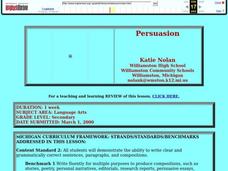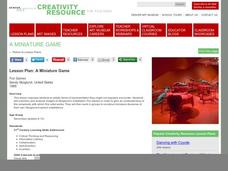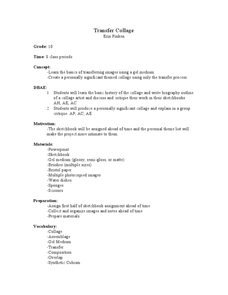Curated OER
Pearl Harbor
Young scholars summarize reasons for the U.S. entrance into WWII. They evaluate the pros and cons of those reasons. Students constrict a time line of WWII events. They write in their journals: What role did emotions play in the U.S....
Curated OER
Persuasion
Students explore the characteristics of a persuasive letter. They label each characteristic and they create a persuasive letter using the correct business letter format. Students recommend a school rule or change of a rule and justify...
Curated OER
Chance Art: Pollock, Cage and Cunningham
Students clearly identify commonalities and differences between dance and other disciplines with regard to fundamental concepts such as materials, elements, and ways of communicating meaning.
Curated OER
Pantomime vs. Abstract Gesture
Students explain dance as a way to create and communicate meaning and demonstrate the difference between pantomiming and abstracting a gesture.
Curated OER
Putting Toxicogenomics To The Test
Students evaluate the pros and cons of a new approach to food, chemical, and drug testing. They read and discuss the Times article, 'DNA Chip May Help Usher In a New Era of Product Testing.'
Curated OER
Old Hobbits Are Hard to Break
Explore film adaptation of literature with this lesson, which focuses on the world of film advertisements. Middle schoolers discuss various films (including The Lord of the Rings) and create advertisements for a pretend film based on a...
Curated OER
Hey - It's a Rainy Forest Out There!
Elementary schoolers take part in a very good lesson which has them watch video, conduct experiments, complete hands-on activities, and work in cooperative groups. The educationally-rich activities are clearly-explained, and the group...
Curated OER
China: Land Beyond the Wall
An excellent series of five lessons on China awaits you and your young geographers. In these lessons, learners engage in hands-on activities, watch streamed video, access websites, and complete activities in cooperative groups in order...
Curated OER
Lesson Plan: A Miniature Game
Art inspires art, as children work to understand artistic forms that come from the imagination. They analyze the installation piece, Fox Games and then discuss the design process. They then use clay to create imaginative dioramas,...
Mathematics Assessment Project
Representing 3-D Objects in 2-D
How does the shape of the surface of water in a container change as water leaks out? After tackling this question, learners take part in a similar activity with more complex figures.
Science 4 Inquiry
An Investigative Look at Florida's Sinkholes
In May of 1981, the Winter Park Sinkhole in Florida first appeared and is now referred to as Lake Rose. Scholars learn about the causes of sinkholes through an inquiry project. Then, they analyze recent data and draw conclusions to...
Science 4 Inquiry
Deforestation
Young scientists observe deforestation from satellite photos and discuss the importance of forests to the global environment. They then simulate a plot of forest when farmers move into the area over the course of seven years. Finally,...
Science 4 Inquiry
Atmospheric Layers
Space diving refers to the act of jumping from outer space and falling through Earth's atmosphere before parachuting to land. Scholars learn about this extreme activity and study the layers of the atmosphere they must conquer in the...
Science 4 Inquiry
Levitation Engineers: Exploring Forces
Levitation tricks have been documented from the early 1900s, so how do they do it? Scholars learn about the force of magnetism in an attractive resource. They watch videos and design experiments to understand the strength and...
Curated OER
Transfer Collage
Complete with a vocabulary list, this five-day lesson outline may get you on your way. Your art class will research Collage technique and famous collage artists. They then create a collage using a gel transfer technique. Steps and...
EngageNY
Construct an Equilateral Triangle (part 2)
Triangles, triangles, and more triangles! In this second installment of a 36-part series, your young mathematicians explore two increasingly challenging constructions, requiring them to develop a way to construct three triangles that...
Curated OER
East Asian Fiction and Non-Fiction Books
Readers explore East Asian culture and literature with a book folder project. Before beginning the project, learners record three beliefs they have about East Asian culture. They then select two books to read and create a display for the...
Norfork School District
Habits of Mind
Why do artists create? To solve a problem, of course. Young artists work individually and then in groups to create observational, imaginative, and narrative drawings in response to an assignment that requires them to employ all 16...
Google
Advanced 5: Evaluating Credibility of Sources
How do discerning readers determine bias and credibility? Ask small groups to figure it out! First, each group is provided with either articles or videos that contain bias. They examine the resources, respond to included questions, and...
Curated OER
Setting the Story: Techniques for Creating a Realistic Setting
“It was a dark and stormy night.” Thus begins the 1830's novel Paul Clifford and, of course, all of Snoopy’s novels! Encourage young writers to craft settings for their stories that go beyond Edward Bulwer-Lytton’s often-mocked phrase...
Curated OER
Sondheim: Voice of Cultural Change
Students explore Stephen Sondheim's contributions to musical theatre in the context of the dramatic cultural shift that occurred in American life in the late 1950s, 1960s, and 1970s.
Curated OER
Life and Art of Pablo Picasso
Art history projects can be a lot of fun. Budding art historians research the life, art, and times of Pablo Picasso, visit the local art museum, and create a multimedia presentation showcasing his art and personal history. Handouts,...
Curated OER
Paradise Lost: Bloom’s Taxonomy of Thinking Processes
Chapter II of John Milton's Paradise Lost provides the text for a series of comprehension questions crafted using Bloom's Taxonomy.
PBS
What Makes A Good Video Report?
As part of a media literacy unit, class members establish criteria for good video reporting, and practice giving both positive (warm) and constructive (cool) criticism.























